The log house, measuring twenty by forty feet, seems hardly big enough to contain all the history it has known.
 At Fort Worth’s Log Cabin Village, this was the home of Isaac Parker. It was built about 1848 and is thought to be the oldest structure in the county, older even than the barn of Lemuel Edwards or the cottage of Khleber Miller Van Zandt.
At Fort Worth’s Log Cabin Village, this was the home of Isaac Parker. It was built about 1848 and is thought to be the oldest structure in the county, older even than the barn of Lemuel Edwards or the cottage of Khleber Miller Van Zandt.
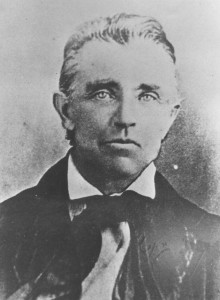 The long life of Isaac Parker was so eventful that perhaps we should look at it in three segments: war, peace, and family. (Photo from Tarrant County College NE.)
The long life of Isaac Parker was so eventful that perhaps we should look at it in three segments: war, peace, and family. (Photo from Tarrant County College NE.)
War
Parker, who was born in Georgia in 1793, just seventeen years after American independence, fought in the War of 1812 and then under Andrew Jackson in the Creek Indian War of 1813-1814. Parker moved to Texas in 1833. But he still had a lot of fight left in him. So, two years later . . .
 he joined the fight for Texas independence. The Texas Revolution began on October 2, 1835 at the Battle of Gonzales. News traveled slowly in those pre-Twitter days: Not until October 31 did the Brazoria Texas Republican reprint Parker’s warning about the movements of Mexican General Martín Perfecto de Cos (General Santa Anna’s brother-in-law). This newspaper article also contains Sam Houston’s “liberty or death” response, urging Americans to come fight with their “brethren” in Texas. (This is the newspaper that on March 2, 1836—Texas Independence Day—would print Colonel William Travis’s “victory or death” letter, written February 24 at the Alamo.)
he joined the fight for Texas independence. The Texas Revolution began on October 2, 1835 at the Battle of Gonzales. News traveled slowly in those pre-Twitter days: Not until October 31 did the Brazoria Texas Republican reprint Parker’s warning about the movements of Mexican General Martín Perfecto de Cos (General Santa Anna’s brother-in-law). This newspaper article also contains Sam Houston’s “liberty or death” response, urging Americans to come fight with their “brethren” in Texas. (This is the newspaper that on March 2, 1836—Texas Independence Day—would print Colonel William Travis’s “victory or death” letter, written February 24 at the Alamo.)
During the Texas Revolution Isaac Parker fought alongside Sam Houston. The two men became friends.
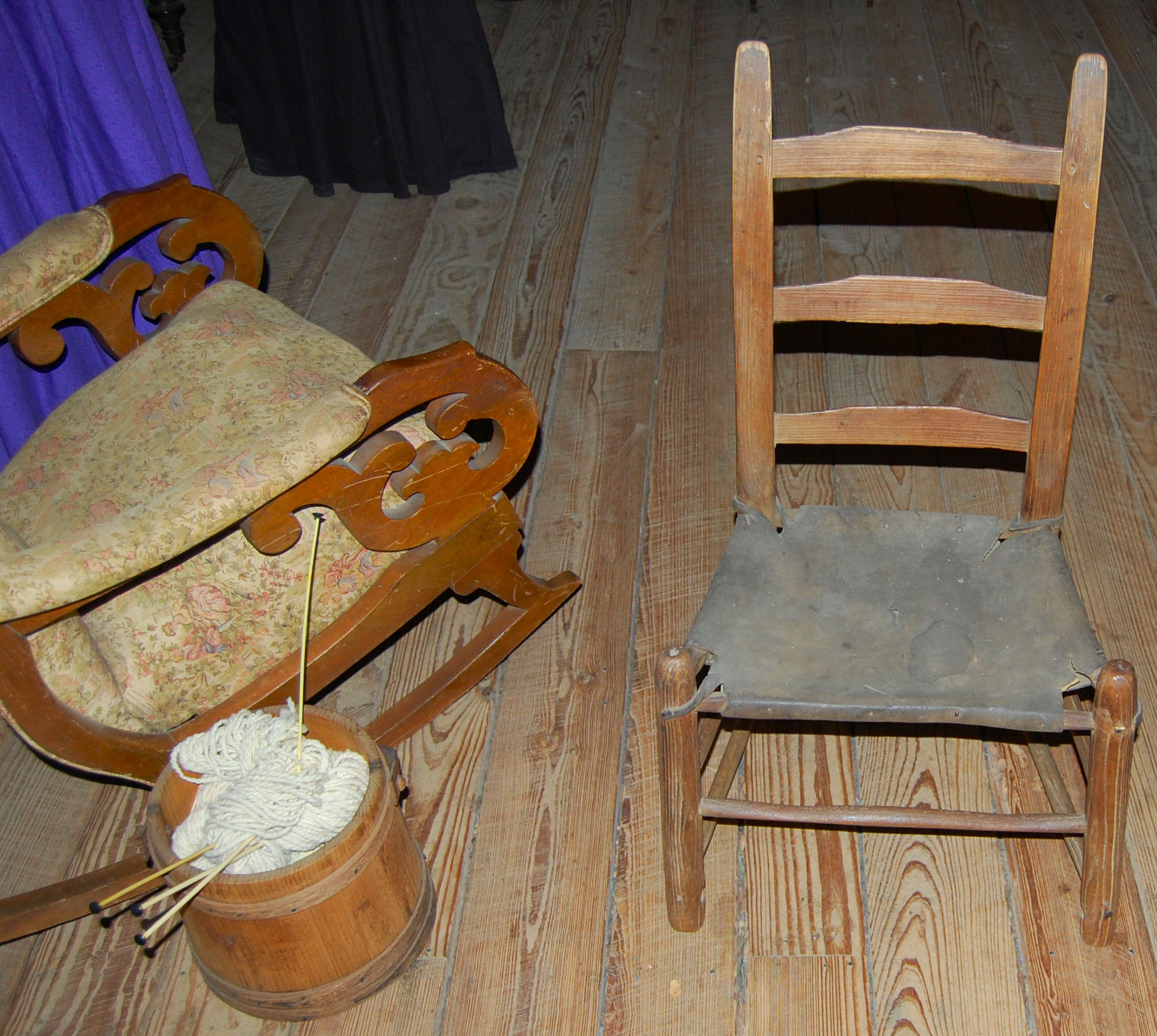 Seat of power: When is a chair more than just a chair? When it’s a chair that Sam Houston sat on. The mule-ear chair on the right, one of the Parker family relics at Log Cabin Village, is said to have been Sam Houston’s preferred chair when he visited the Parkers in Tarrant County.
Seat of power: When is a chair more than just a chair? When it’s a chair that Sam Houston sat on. The mule-ear chair on the right, one of the Parker family relics at Log Cabin Village, is said to have been Sam Houston’s preferred chair when he visited the Parkers in Tarrant County.
In 1841 Isaac Parker fought Native Americans in the Battle of Village Creek in present-day Arlington. (Twenty years later, according to the Portal to Texas History, Parker fought in the Civil War in the Texas Brigade. He would have been almost seventy years old. But as we’ll read below, Isaac Parker was always young for his years.)
Peace
Eventually Isaac Parker traded smoke-filled battlefields for smoke-filled rooms: The soldier became a politician. He was a representative and senator in the legislature of the Republic of Texas from 1838 until 1845. Upon annexation in 1845, he was a delegate to the state constitutional convention.
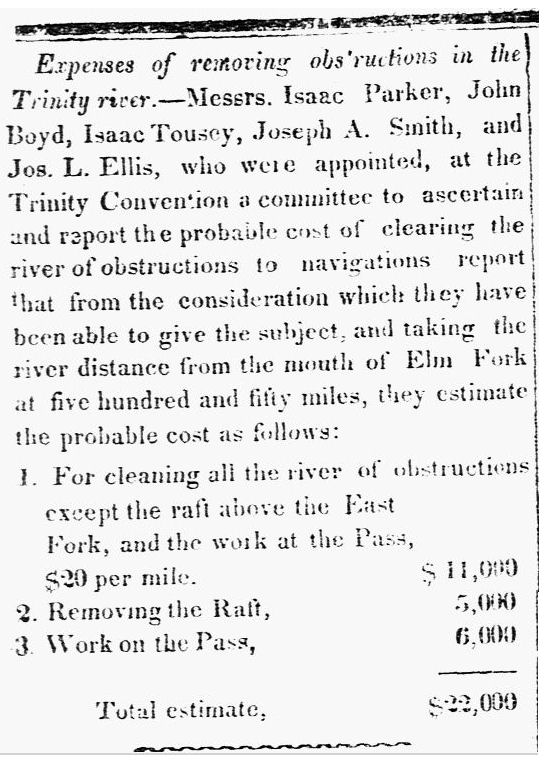 Parker then served as a senator in the state legislature (1846-1853). This clip about navigation of the Trinity River is from the Clarksville Standard in 1848. From 1855 to 1856 Parker, while living in Birdville, represented Ellis and Tarrant counties in the House, where he introduced the bill to establish Parker County, which was named for him. According to historian Julia Kathryn Garrett, Parker also authored the law that allowed residents of a county to relocate the county seat by a two-thirds vote instead of a majority vote. This law would come back to bite Parker’s Birdville.
Parker then served as a senator in the state legislature (1846-1853). This clip about navigation of the Trinity River is from the Clarksville Standard in 1848. From 1855 to 1856 Parker, while living in Birdville, represented Ellis and Tarrant counties in the House, where he introduced the bill to establish Parker County, which was named for him. According to historian Julia Kathryn Garrett, Parker also authored the law that allowed residents of a county to relocate the county seat by a two-thirds vote instead of a majority vote. This law would come back to bite Parker’s Birdville.
Family
In 1836, when Isaac Parker was forty-three and living in the family’s Fort Parker in Limestone County, the fort was attacked by Comanches led by chief Peta Nocona. Parker survived the attack, but his father and two brothers were killed, and his niece and nephew, Cynthia Ann Parker, age eight, and John Parker, age six, were abducted. In time Cynthia Ann would become Peta Nocona’s wife.
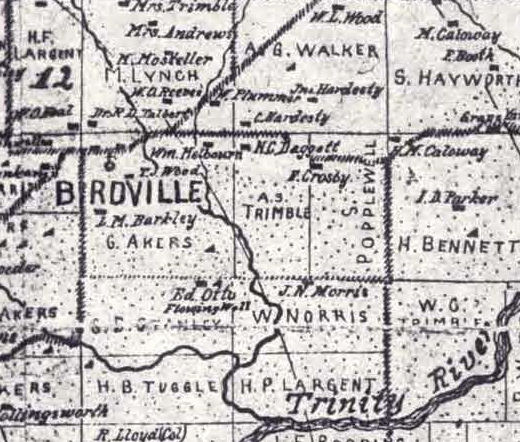 In 1853 Isaac Parker bought from Hamilton Bennett land east of Birdville, located about where East Loop 820 and Hurst Boulevard intersect today. Parker moved his family into the log house, which Bennett had built about 1848. In this log house lawmaker Parker read and wrote legislation.
In 1853 Isaac Parker bought from Hamilton Bennett land east of Birdville, located about where East Loop 820 and Hurst Boulevard intersect today. Parker moved his family into the log house, which Bennett had built about 1848. In this log house lawmaker Parker read and wrote legislation.
As Parker grew more prosperous, he added on to the log house until its exterior was covered by milled lumber. This detail from Sam Street’s 1895 county map labels the house, by then owned by son Isaac Duke Parker. (Map from Pete Charlton’s “The Lost Antique Maps of Texas: Fort Worth & Tarrant County, Volume 2” CD.)
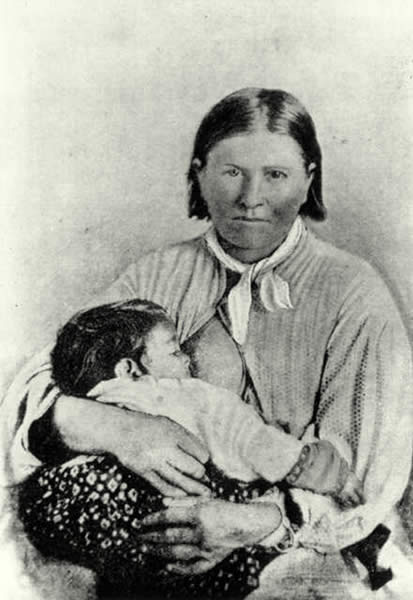 In 1860, twenty-four years after her abduction, Parker’s niece Cynthia Ann was “freed” from Peta Nocona’s tribe by Texas Ranger Captain Sul Ross at the Battle of Pease River. Ross suspected that the blue-eyed woman was Cynthia Ann Parker, but he was not certain.
In 1860, twenty-four years after her abduction, Parker’s niece Cynthia Ann was “freed” from Peta Nocona’s tribe by Texas Ranger Captain Sul Ross at the Battle of Pease River. Ross suspected that the blue-eyed woman was Cynthia Ann Parker, but he was not certain.
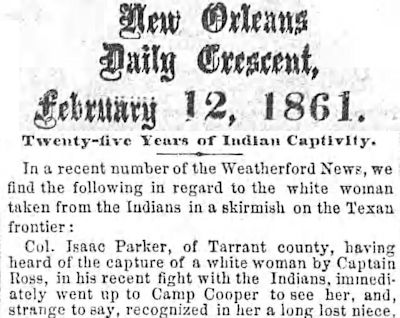 Isaac Parker, by then sixty-seven, went to Fort Cooper in Throckmorton County to identify his niece, whom he had not seen since the attack on their family. Uncle and niece did not recognize each other, did not have a common language. According to one story, Captain Ross (who would be elected governor in 1886) asked Isaac Parker to note Cynthia Ann’s reaction as Ross called out her white name in a high-pitched voice to imitate what Cynthia Ann would have heard from her mother twenty-four years earlier. Cynthia Ann is said to have smiled and tapped her chest in recognition. Isaac Parker took his niece to his home in Birdville, home to his family’s log house. He later took her to Austin, where he got a state bill passed to grant his niece a pension of $100 a year and a league (4,400 acres) of land. Cynthia Ann lived with her uncle for two years. But for Cynthia Ann Parker, repatriation with her white family did not compensate for removal from her Native American family and, in 1864, for the death of her daughter, Prairie Flower (shown with Cynthia Ann in photo). Cynthia Ann Parker, heartbroken, is said to have starved herself to death. She died in 1870 at age forty-two. She is buried in Fort Sill next to her son, Comanche chief Quanah Parker. (Photo from Wikipedia.)
Isaac Parker, by then sixty-seven, went to Fort Cooper in Throckmorton County to identify his niece, whom he had not seen since the attack on their family. Uncle and niece did not recognize each other, did not have a common language. According to one story, Captain Ross (who would be elected governor in 1886) asked Isaac Parker to note Cynthia Ann’s reaction as Ross called out her white name in a high-pitched voice to imitate what Cynthia Ann would have heard from her mother twenty-four years earlier. Cynthia Ann is said to have smiled and tapped her chest in recognition. Isaac Parker took his niece to his home in Birdville, home to his family’s log house. He later took her to Austin, where he got a state bill passed to grant his niece a pension of $100 a year and a league (4,400 acres) of land. Cynthia Ann lived with her uncle for two years. But for Cynthia Ann Parker, repatriation with her white family did not compensate for removal from her Native American family and, in 1864, for the death of her daughter, Prairie Flower (shown with Cynthia Ann in photo). Cynthia Ann Parker, heartbroken, is said to have starved herself to death. She died in 1870 at age forty-two. She is buried in Fort Sill next to her son, Comanche chief Quanah Parker. (Photo from Wikipedia.)
Isaac Parker’s wife, Lucy, died in 1867. Three years later, at age seventy-six, Isaac Parker remarried. In 1872 Parker and his second wife, Virginia, moved west, to a farm eight miles from Weatherford.
Isaac and Virginia had four children. The couple gave to their last child a name that brings to mind firsts: “Adam.” Adam Parker was born about 1879. In 1879 proud papa Isaac Parker was eighty-six years old.
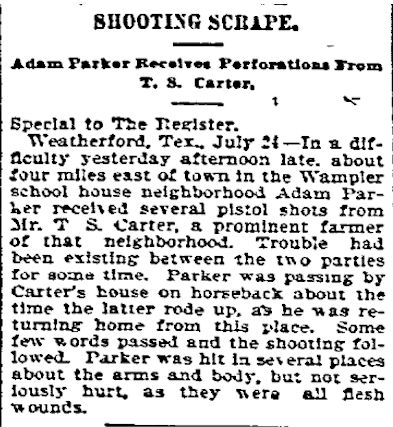
 (Isaac Parker’s son Adam and Sam Houston’s son Temple had some similarities: Each son was the last child born to his father; each father was born in 1793; each father died before his son was five years old; both sons were lawyers; and perhaps Adam, like the flamboyant Temple, had trouble avoiding violence. These two clips are from 1900 and 1908.)
(Isaac Parker’s son Adam and Sam Houston’s son Temple had some similarities: Each son was the last child born to his father; each father was born in 1793; each father died before his son was five years old; both sons were lawyers; and perhaps Adam, like the flamboyant Temple, had trouble avoiding violence. These two clips are from 1900 and 1908.)
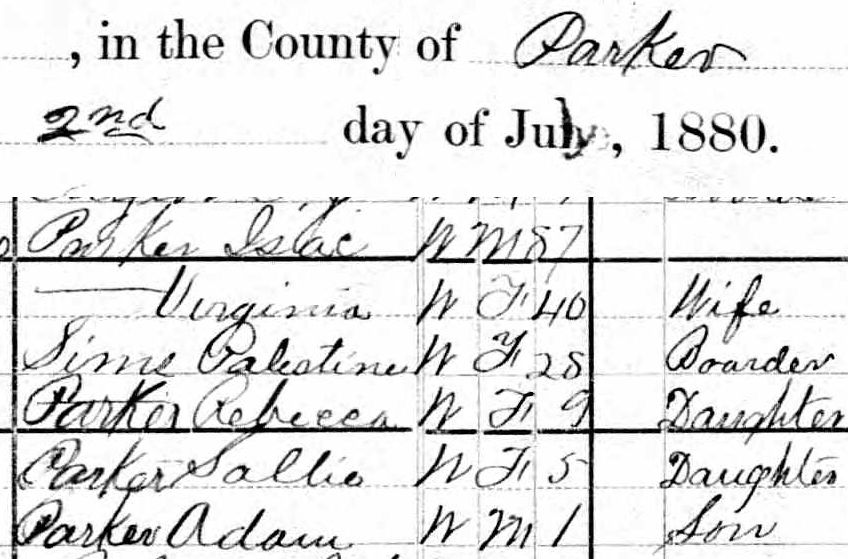 The 1880 census shows Isaac, then eighty-seven, and Virginia, forty, to have three children under the age of ten.
The 1880 census shows Isaac, then eighty-seven, and Virginia, forty, to have three children under the age of ten.
On April 14, 1883 Isaac Parker (who by now you may be thinking was well-nigh immortal) died in the county that was named for him:
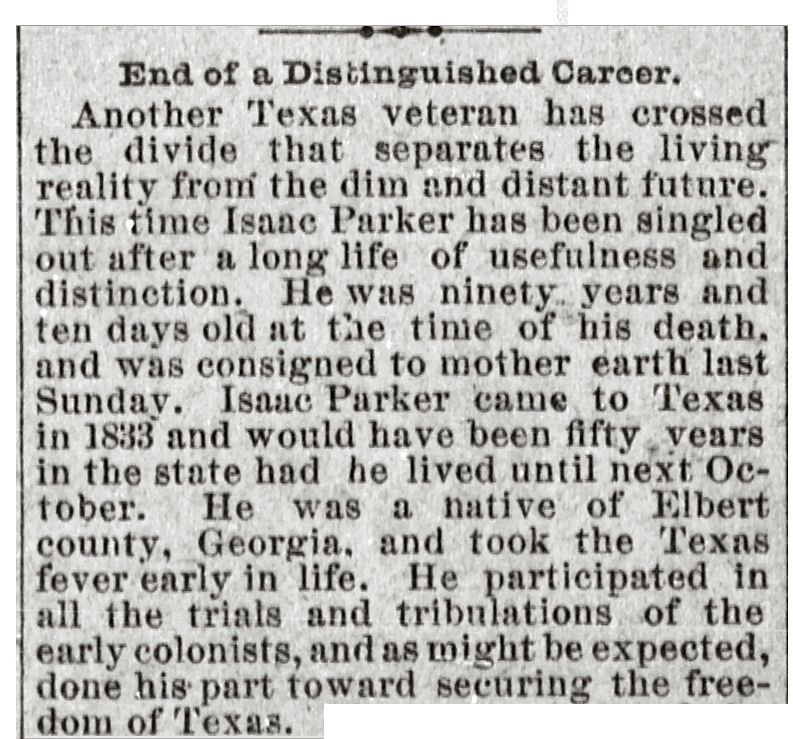
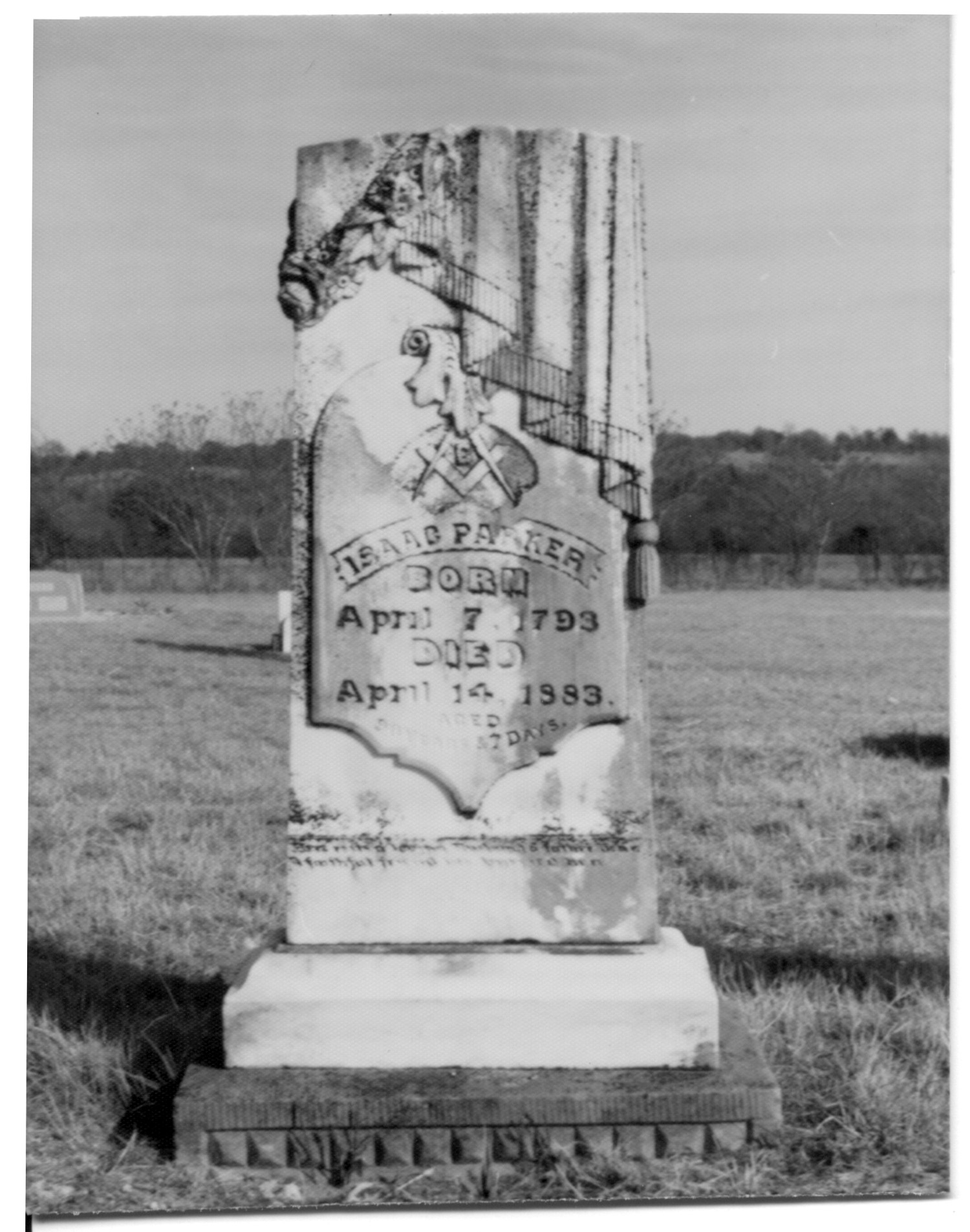 Isaac Parker is buried in Turner Cemetery in Parker County. (Photo from Tarrant County College NE.)
Isaac Parker is buried in Turner Cemetery in Parker County. (Photo from Tarrant County College NE.)
The Parker Cemetery in Hurst is located on the old family homestead.
 Dogtrot postscript: In 1927 Star-Telegram publisher Amon Carter bought the Parker house, moved it to his ranch, and had the building restored to its original condition. The house is a dogtrot: Cooking/dining area and living/sleeping area are under a common roof but separated by a center breezeway. After Carter died, his foundation donated the log house to the city, and it was moved and reassembled at Log Cabin Village. (Photo from Down Historic Trails of Fort Worth and Tarrant County.)
Dogtrot postscript: In 1927 Star-Telegram publisher Amon Carter bought the Parker house, moved it to his ranch, and had the building restored to its original condition. The house is a dogtrot: Cooking/dining area and living/sleeping area are under a common roof but separated by a center breezeway. After Carter died, his foundation donated the log house to the city, and it was moved and reassembled at Log Cabin Village. (Photo from Down Historic Trails of Fort Worth and Tarrant County.)






Interesting history. Thanks for sharing. Good old family stories.
Hello Mike and Betsy, My dad attended Weatherford College a couple of years. He was friends with the Yates that ran the store in Grapevine. I remember visiting them a few time at the store and home in Grapevine. I know that their friendship started at Weatherford College and I always believed the Yates family was from Weatherford.
When I interned with Grapevine Convention & Visitors Bureau in 2015, we received a collection of family papers from the descendant of the Yates family who owned Yates Dry Goods, a store on Main Street, Grapevine, for 125 years. In the collection was a Power of Attorney signed by Isaac Parker, who was a Tarrant County attorney. Imagine how awed and honored I felt, as a Cynthia Ann historian, to hold that document in my hands! I do not know why the POA was in the Yates collection, and my internship was finished before I had a chance to track the name on the document. It must’ve been a distant relative, but the genealogy was not clear. The collection is currently being scanned for Portals to Texas History, and will be online for research soon.
Indeed a heap o’ history in that signature. The hand that wrote it no doubt shook the hand of Sam Houston, held a gun during more than one war, and in 1860 welcomed Cynthia Ann Parker “home.”